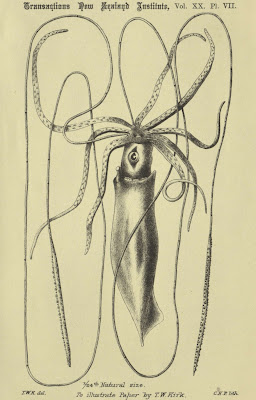
To illustrate PARTIAL IMPACT, Article IV Volume 12, 1879

Rorqualas minor Volume 2, 1869

Skeleton of Cnemiornis Calcitrans - Volume 6, 1883

Skeleton of Euphysetes Pottsli, Haast. 1 ninth nat size. - Volume 6, 1883

Mustelus Antarcticus Volume 15, 1882

Myosotidium Nobile, Hook Volume 7, 1884

New Opistho-Branchiate Mollusca. Volume 11, 1878

Aleurodidæ Volume 28, 1895

Oreosoma atlanticum Cuvier and l'Valenciennes. - Volume 44, 1911

Palinurus Tumidus sp. nov Volume 12, 1879

Aegoeonichthys Appelii ClarkeEdgar R Wte del - Volume 44, 1911

To illustrate Paper by T. W. Kirk. Volume 20, 1887

Ardetta Maculata Volume 6, 1873

Rock Pictographs. Opihi River & Howell's
Creek, Opihi River Volume 30, 1897
Creek, Opihi River Volume 30, 1897

To illustrate Paper by E. Tregear. Volume 20, 1887

Maori Spirals (Tregear) Volume 32, 1899

Historic Maori Personages.—Downes. Volume 38, 1905
[click on images for much larger versions]
(some of the above images are from trimmed plates, are details
and/or have been cleaned up in the background a little)
The National Library of New Zealand joined forces with the New Zealand Royal Society to fully digitize the Proceedings and Transactions of the Royal Society of New Zealand 1868-1961 [click 'Picture Gallery']. This is an extensive collection with a zippy interface and both thumbnails and very large jpeg or pdf images.
via Tellurian. (Oh, and thanks TMN!). I still have something north of 500 unread items in the feedreader and continuing obligations elsewhere but I can nearly see some clear sailing ahead.
Splendid. Thank you. :-)
ReplyDeleteMy attention was arrested by the Cnemiornis Calcitrans since my first thought was "moa skeleton!" but it is a goose, whereas moas are dinornis. Of course, considering the actual heft of moa leg bones, there's no way one should confuse the two... (am I getting incoherent? evidently, and I blame the train conductor who woke me and interrogated me at 2:00 last night) But when you have the Royal Society of New Zealand, moas come to mind rather than geese. Ah well.
ReplyDeleteThanks Johannes.
ReplyDeleteAwwww Karla! I purposefully didn't go and look up the Cnemiornis name because I had this funny feeling it wasn't a Moa. If I didn't check I could still pretend. Ah well.
Good thing (from your twisted link) there are no moas in Oz, if Joeys are a dietary requirement. *yes, that joke is bad*
Oops, how could I have shattered the illusion... very bad of me but I did have to see if Cnemiornis was a new type of moa, and dang it warn't.
ReplyDeleteKeep those joeys of yours safe from replica moas, I like the little critters. The inspirational moa replica can still (last I checked) be seen in a dusty state at the Národní muzeum here but the model of the chicken's digestive tract seems to have vanished. The "our bats" exhibit (or was it the foreign bats, I'm not sure anymore) had to be kept out of the story as a bit ribald and voyeuristic, if you can imagine such a thing in a museum display case.
But as for the moas (one can never have enough about moas), there is a gorgeous volume on extinct birds tucked away in one of my storage boxes. It might be available somewhere still... I think the title was precisely Extinct Birds.
Maori Spirals (Tregear) Volume 32, 1899. I find that to be amazing - they would be the least Maori 'spirals' ever. Compare Rock Pictographs. Opihi River & Howell's Creek, Opihi River Volume 30, 1897 - a more typical representation of the flowing, organic spirals found in Maori art. The Maori 'spirals' may have been created by a Maori person exploring some European design concepts, but it is by no means a traditional design.
ReplyDelete